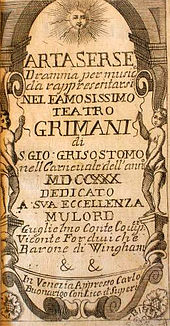
Artaserse is the name of a number of Italian operas, all based on a text by Metastasio. Artaserse is the Italian form of the name of the king Artaxerxes I of Persia.
Contents
There are over 90 known settings of Metastasio's text. The libretto was originally written for, and first set to music by Leonardo Vinci in 1730 for Rome ( Artaserse ). [1] It was subsequently set by Johann Adolph Hasse in 1730 ( Artaserse ) for Venice and in 1760 for Naples, by Christoph Willibald Gluck in 1741 for Milan, by Pietro Chiarini in 1741 for Verona, by Carl Heinrich Graun in 1743 for Stuttgart, by Domènec Terradellas in 1744 for Venice, by Baldassare Galuppi in 1749 for Vienna, by Johann Christian Bach in 1760 for Turin, by Josef Mysliveček in 1774 for Naples ( Artaserse), by Marcos Portugal in 1806 for Lisbon and many other times. The text was often altered.
Thomas Arne's 1762 Artaxerxes is set to an English libretto that is based on Metastasio's. Mozart's aria for soprano and orchestra "Conservati fedele" (K. 23, 1765) is set to the parting verses of Mandane (Artaserse's sister) at the end of the first scene.
The opera was famously performed in 1734 as a pastiche of songs by various composers such as Johann Adolf Hasse, Attilio Ariosti, Nicola Porpora and Riccardo Broschi. It was in this that Broschi's brother, Farinelli, sang one of his best-known arias, "Son qual nave ch'agitata".